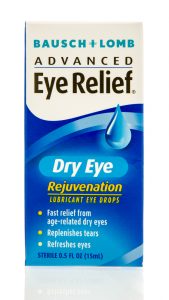How to Treat Your Dry Eye


The normal tear film is composed of the 3 layers;
- Oily film – sits on top of the tear film and prevents evaporation
- The water tear layer – in the middle
- Mucin – a special substance which allows the tears to spread evenly over the eye
Almost all dry eye patients have either;
- Rapid evaporation due to sub-optimal oily layer
- Insufficient tear production
Artificial Tears and Lubricants
Most patients have mild or moderate dry eye. Regular use of artificial tears and lubricants are often very satisfactory. A common symptom of dry eye is tearing – resulting when the corneal surface has already dried.
Proper use of artificial tears includes regular and routine use before symptoms of dry eye have developed. The goal of artificial tears is to prevent the symptoms of dryness.
Punctal Plugs
Each eye has two tiny tear ducts located on each lid adjacent to your nose. These tear ducts are quite efficient at draining tears and explains why you blow your nose when crying; all the tears drain right into your nose!
Punctal plugs simply occlude or stop these ducts from draining away your precious tears. The plugs are inserted in the office, are removable or dissolve, and are often a great treatment for dry eye due to poor tear production. They are a great alternative for patients who detest the nuisance of regular eye drops.
Restasis and Xiidra
Ocular inflammation can cause poor tear production.
Restasis and Xiidra treat dry eye by reducing ocular inflammation. Restasis has been the topical eye drop of choice until Xiidra was recently FDA approved.
Restasis and Xiidra reduce inflammation differently and, with the introduction of Xiidra, our patients in whom Restasis fails, now have a new alternative. The reverse may be true as well, out patients who do not respond to Xiidra may find relief with Restasis.
Meibomian Gland Dysfunction – Rapid Tear Evaporation
The meibomian glands are located at the edges of your eye lids. There are dozens on each lid. These glands produce an oily substance called “meibom” which form an oily coating of the tear film preventing evaporation,
Abnormalities in either the quantity or quality of “meibom” lead to rapid evaporation and dry eye.
Intense Pulse Light Treatment (IPL)
Intense Pulse Light Treatment, or IPL, is a very effective treatment for patients with meibomian gland dysfunction (MGD).
Using a special Xenon light, pulses of light are directed to abnormal blood vessels located along the edges of your lids. The abnormal blood vessels indirectly increase the ocular inflammation leading to dry eye. The light allows the meibomian gland to improve and, then, your dry eye.
MiBo Thermoflo
We have great success with both the IPL and MiBo Thermoflo. MiBo directly massages the meibomian glands with heat to improve the excretion and quality of the meibom. With improved meimbom, tear evaporation returns to normal.
MiBo Thermoflo is performed in the office, drug free, and is a comfortable and safe treatment for our patients with dry eye from meibomian gland dysfunction (MGD).
If you are trouble with dry eye. Call us to make an appointment or email us!
We look forward to seeing you.
Gregory Scimeca, M.D.
Ophthalmologist and Medical Director
Burlington County Eye Physicians
Eye Professionals, LLC (Millville, NJ)
Eye Physicians and Surgeons of Bucks County (Langhorne, PA)
